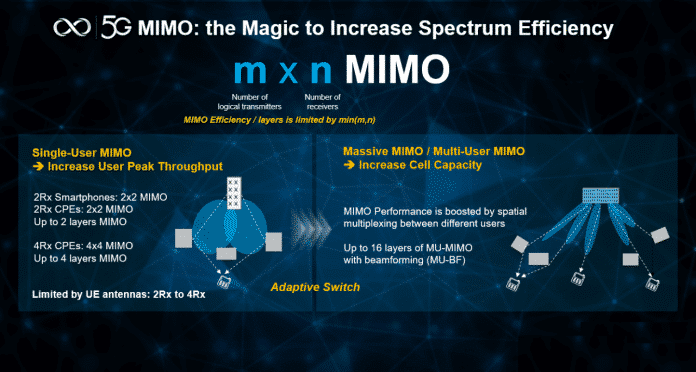Multi-User MIMO
Simply, SU-MIMO is the same MIMO we know from LTE networks. It will provide multiple layers of communications to handset for increasing of throughput. Each communication layer added to the User will increase the final throughput based on number of layers. Extra layers are been added using extra antennas in space diversity and more Transmitters in Base-station side.
So what is the big difference in SU-MIMO already used in LTE and SU-MIMO in 5G NR?
Answer is very simple , it just the beam width & Number of layers. In LTE networks , it is wide beams propagate in entire angle of the sector. But in 5G NR, beams are narrow (Massive MIMO using 64T64R antenna array).
Also number of layers can be added to a single user in Massive MIMO 64T64R array is huge. Theoretically, the number of layers are depends on number of Transmitters in base-station side. Massive MIMO AAU has 64 TX channels which means 64 layers can be added. But practically it is not possible as current algorithms cannot reduce co-channel interference of such large number of transmission layers. Current 5G systems only supports maximum 16 layers. But in SU-MIMO, 16 layers to a single user is not possible due to UE side limitations. Currently UEs are only support 2T4R antenna structure . So in SU-MIMO can have only maximum four layers to a single user.
Multi User MIMO
Main difference in MU-MIMO and SU-MIMO is that MU-MIMO improve cell throughput by utilizing same DL resources (OFDM Frequency and time resources or the RBs) shared between multiple users in same beam direction where the case of less throughput required per user. So the Cell throughput will be improved by sending more data to more users in same TTI. This technique will improve spectrum efficiency also. In SU-MIMO, all resources was allocated to single user and will improve single user throughput.
MU-MIMO also supports up to four layers per user and maximum 16 layers per cell means four users with four layers can be paired at a time or eight users with two layers or 16 users with single layer pairings are possible.
Benefit from Massive discount on our 5G Training with 5WorldPro.com
Start your 5G journey and obtain 5G certification
contact us: contact@5GWorldPro.com



